For healthcare content marketing to succeed, it needs to be created to the highest standard.
We spoke with the industry’s leading experts and surveyed hundreds of healthcare professionals to create this 5-step guide.
Explore it to build a powerful content marketing strategy for your healthcare business and learn how to:
- Understand the content needs of your audience
- Identify the healthcare topics that resonate
- Ensure compliance and quality of your content
First, What Is Healthcare Content Marketing?
Content marketing offers healthcare providers the opportunity to capture local and international search traffic and differentiate themselves from the competition.
Content marketing in healthcare is a way for brands to connect with a large and interested target audience of patients and healthcare organizations, through sharing valuable and relevant multimedia content.
Why Do Healthcare Companies Need Content Marketing?
For better or worse, Google has become the de facto doctor’s surgery. According to Becker’s Hospital Review, there are a billion healthcare-related searches a day.
This puts healthcare companies in a good position to offer valuable and actionable advice through content marketing.
Healthcare content marketing has the following key benefits. It allows your organization to:
- Build trust in your business by showing the expertise and people behind your company
- Reduce patient anxiety by showing people what to expect, and answering their questions and doubts in a straightforward way
- Catch the attention of local search traffic, generating more long-term leads and knocks on the front door
- Differentiate from the competition and establish an audience that keeps coming back for more
Healthcare brands that participated in our State of Content Marketing 2023 Global report find content marketing to be a successful approach.
99% of companies we surveyed generated positive results with their content.
Over a quarter (33%) say they are very successful in their content marketing efforts; 33% say they have moderate success; and 10% claim to be very successful.
Explore this infographic with other important details about the current state of healthcare content marketing:

A Spotlight on Healthcare Content Marketing Success
Take, for example, Mark Oborn Ltd., a digital dental marketing agency that recognizes the value of content marketing in healthcare.
The agency was able to use a bold and targeted content marketing strategy to triple conversions for a dental clinic through blog posts in just 6 months.
How? By focusing on blog traffic growth to improve digital conversions.
Mark was able to drive more requests for appointments, phone calls, and bookings through the website, achieving 19,000 organic visits to the blog post per month.

Read Mark Oborn’s story to learn more about how his healthcare marketing agency’s approach worked.
How to Distinguish Between B2B and B2C Healthcare Content?
Healthcare content marketing has two distinct targets:
- Business to consumer (B2C): This refers to clients, patients, or other individual healthcare consumers
- Business to business (B2B): This refers to health-related companies and organizations
Pavel O., Head of Growth at PurposeMed, says:
There are a couple of big differences between B2B and B2C. First, the (often) shorter buying cycles with B2C bring more opportunities to play on impulsivity and emotions to influence immediate action. And second, the lack of multiple decision-makers also makes it easier to focus on solving a single person’s problem rather than a combination of interlinked users.
Other factors you will need to consider include:
1. Language and tone
B2B buyers in healthcare tend to be used to more complex language and a straightforward tone of voice. B2C buyers, however, range in age and experience.
Your content should be adapted so that it is unambiguous and can be easily understood by the general public.
Ann Key, Content Strategist at the Aha Media Group, says:
There’s no place for jargon in healthcare content—especially when you’re writing for a patient or caregiver audience. Accessing reliable health information should be the easiest part of the patient journey.
2. Complexity of content
Similarly, content created for a B2B audience should be pitched to their level of expertise. On the other hand, B2C audiences have a very varied level of expertise.
Your content should walk people through processes step by step and never assume previous knowledge of a topic. However, opting for simplicity is a good idea in either case.
Ann Key advises:
Plain language and chunky formatting should be the rule of thumb. Even brain surgeons are pressed for time and appreciate content that allows at-a-glance comprehension.
3. Distribution channels
Your content distribution channels are likely to vary quite a lot between B2B and B2C audiences.
- In B2C, you might find a lot of content is shared via short, shorter blogs, or on social media channels, in easy-to-consume, bite-sized chunks.
- In B2B healthcare content, you might instead see more examples of whitepapers, long-form blogs or research-driven guides, and industry-focused newsletters or webinars.
But there are no hard and fast rules. The important thing is that your audience is able to consume your content in the most effective way for them.
Now, let’s look at the 10 key steps you need to take to position your healthcare content marketing for success—based on expert insights and our research.
Step 1: Turn to Your Community and Patients for Content Marketing Insights
The first step is to reach out to your audience and learn about their questions that you can address in your content. This will help you create the foundations for a customer-centric content strategy.
There are several ways healthcare companies can choose to do so.
Ann Key says:
Solicit questions directly from your community. You can have them send health questions to a dedicated email address (like AskAnExpert@YourHospital.com), via a website submission form or through direct messages on social media platforms.
She adds that it’s important to make it clear that these platforms aren’t appropriate for sharing personal health information.
Some brands even choose to create their own community platforms to engage with their customers. Take, for example, this Facebook community group by Parsley Health:

You can also source content ideas internally. This includes asking your clinical teams about their own passion projects and seeing how these can align with the needs of your audience.
It might also involve collaborating with your customer-facing teams, such as customer support, to analyze the requests and questions made by patients and prospects.
Finally, traditional audience research is essential for content marketing. Rushing into content creation before getting a deep understanding of your content marketing audience usually leads to poor results, if any.
Stephen E., Content Marketing Manager at Maven Clinic, says:
Listen to your audience. If you can, schedule time with customers and interview them, understand what kind of problems your audience has and put it in layman’s terms. Find out what words and phraseology they use to talk about their industry, and adapt that into your writing. Depending on who you’re selling to (purchasers of healthcare solutions, for example), the language changes significantly—and search can only tell you so much.
When speaking with your clients and prospects, find out the following to ensure you have enough information to create content that resonates:
- What are their goals and challenges?
Once you have a good understanding of your customers’ pain points—even going beyond those you can address with your product—you can create content that tackles them.
Note: You should not solicit, store or share any sensitive personal or medical information.
Dobi Nastova Frankewycz, a Senior Content Writer, says:
In regards to compliance, healthcare companies and their content teams should follow HIPPA compliance. General medical advice, industry insights, and treatment or medicine advances are ok. But, sharing patients’ private, confidential medical records is a NO.
- What are their preferred ways of communicating, channels, and content formats?
This will help you make the decision about the best platforms for sharing your content and the most effective media types to opt for.
- How do they communicate with each other and with other brands?
Finally, pay attention to the language they use. For example, do they communicate with you in a professional tone or are they more casual? This will help you understand which tone of voice to take when addressing this particular audience.
Step 2: Identify the Healthcare Topics that Interest Your Audience
Once you have a high-level understanding of your audience and your community, it’s time to find the specific topics to include in your content plan.
Build Your Topical Authority
Topical authority is about enhancing your expertise on a particular topic and in a particular niche.
By creating large volumes of quality content around a specific topic, you can build trust with your audience and send positive signals to search engines.
For example, let’s imagine you create content for a mental health clinic and you noticed growing demand and interest in depression treatment services.
If you want to build a topical authority in that space, it’s important to create quality content tackling each potential subtopic and question related to depression.
Ann Key says:
No matter the topic, there are at least 25 ways you can talk about it. Once you’ve brainstormed the topic around your personas’ needs, you can leverage keyword research to hone the ideas and zero-in on your topic focus–the Content Marketing dashboard in Semrush is a great tool for this.
Let’s try it out:
First, head to the Semrush Topic Research Tool and enter the ‘depression’ topic and choose the location of your preference (country, region, or city).

Hit ‘Get content ideas’ and generate a range of connected subtopics. You can choose different views, for example, the Mind Map.
Note that the topics marked in red are those that have been trending lately.
You will also see a range of popular headlines, and questions users across the web, as it relates to each subtopic.

From here, you can immediately start creating a list of topics to include in your topic cluster. For example, our clinic could decide to focus on the following high-level content ideas:
- Risk factors of depression
- Psychotherapy and medications
- Persistent depression disorder
- Bipolar disorder
- Clinical depression
- Postpartum depression
- Mood disorders
- Brain stimulation therapy
…and others.
Note that some of those subtopics might become content pillars (or cluster centers) on their own.
Do the Keyword Research
Each topic in your content plan would have a number of related keywords. Running keyword research for every content piece will help you tailor your content to the needs of users searching online and estimate the potential gains.
Let’s imagine we’ve picked the ‘brain stimulation therapy’ topic from the list above. Head to the Keyword Magic Tool and type it in.

You will see a list of related keywords, the search volume, the search intent, and keyword difficulty.
Let’s also assume you believe that this keyword is worth pursuing. This decision will depend on your estimate of the results it will bring and the resources it will take to rank.
The keywords for your piece might include:
- brain stimulation therapy
- brain stimulation therapy for anxiety
- brain stimulation therapy for depression
- magnetic brain stimulation therapy
- brain stimulation therapy definition
Your next step is to think about the semantically-related keywords. These can help you add more context and information to the piece.
Head to the SEO Content Template tool and type the ‘brain stimulation therapy’ keyword.
Hit ‘create content template’ to generate a list of the semantically-related keywords, and see other details such as the optimal content length and target readability.
You can then download it as a Word Doc.

Our mental health clinic might want to include such related keywords as ‘areas of the brain’, ‘side effects’, ‘treatment-resistant depression’, ‘electrical pulses’, and others.
Finally, to further expand your list of related questions to cover in your piece, you can always go back to the Topic Research tool.
There you can check out the most popular headlines and questions related to your subtopic.

Read Around Social Media and Industry News
Your analysis of the topics and trends should not, of course, be limited to the workflow presented above.
In fact, it’s essential to explore other available platforms to get a better understanding of your audience and their needs.
Janne Marie Wendel, SEO Advisor and Content writer at Publicis Groupe, says:
Read forums, check different social media platforms to see if content is being created and shared around relevant health issues. There are several “channels”, profiles or groups sharing openly about experiences, challenges and so on, that can spark engagement and discussions and in turn be relevant topics to address in content.
You can also attend industry events to stay on top of trends and jump on recent news stories to create useful content on a popular topic. This is called “newsjacking”.
In the following example from Mayo Clinic, they have created a series of YouTube videos presenting scientific evidence to help combat misinformation about COVID-19.

As a result, each video has from 7,000 to 300,000+ views—largely because Mayo Clinic managed to tackle the most burning questions. For example, ‘Will young children experience side effects from the COVID-19 vaccine?’.
To follow in Mayo Clinic’s footsteps:
- Set up a list of industry resources, publications, and journals
- If possible, support reported facts with your own original research
- Sign up for Google alerts, if it’s available in your country
- Follow relevant topics on Twitter and follow relevant hashtags on LinkedIn
- Explore relevant questions and conversations on Quora and Reddit
- Create authoritative content in response—with input from your own subject matter experts
- Use the Topic Research tool to find the latest trending topics
For instance, if our mental health clinic wanted to create timely content about combatting anxiety, the tool can suggest a few themes that have been trending lately. For example, the connection between traumatic events and anxiety:
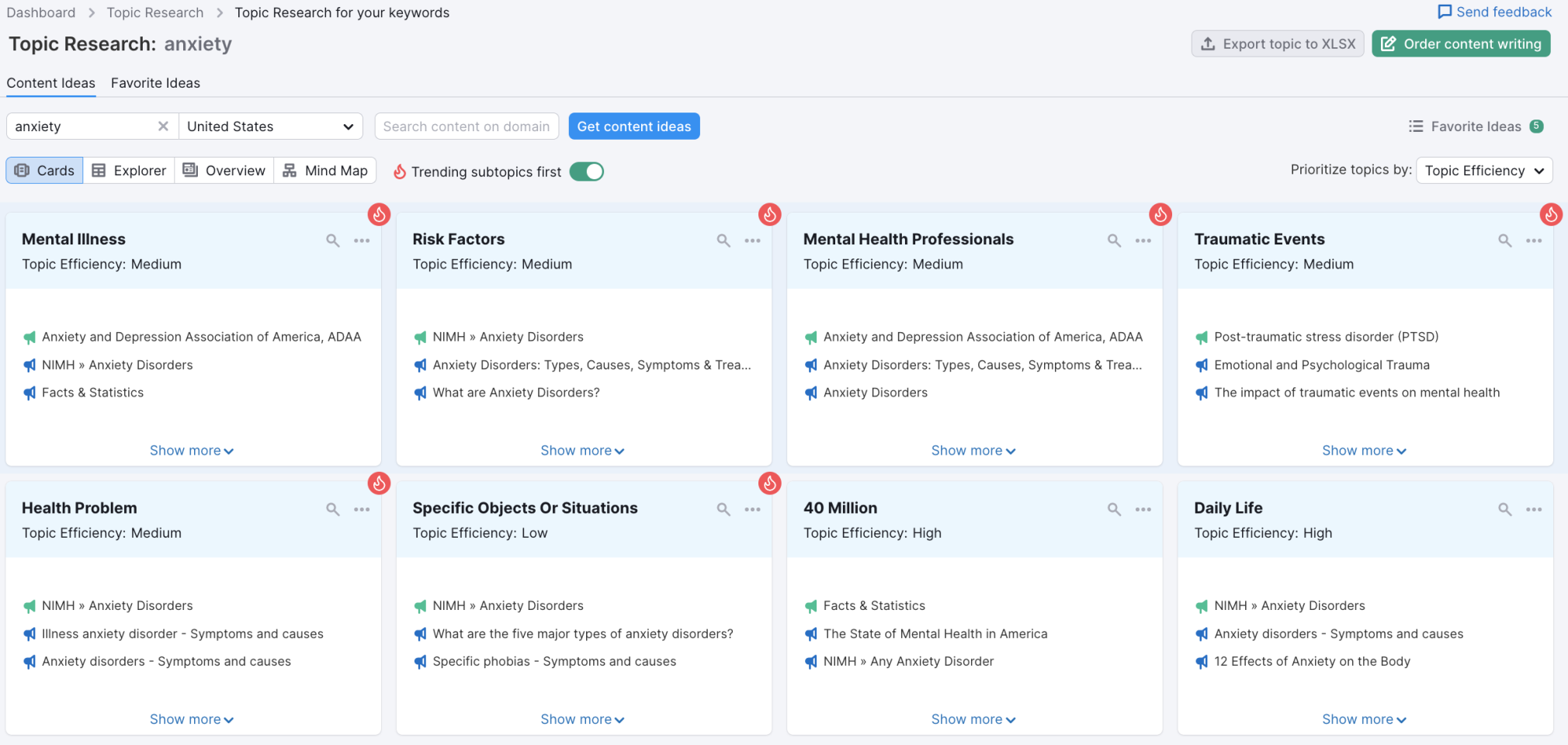
Leverage Competitive Analysis
Finally, any search for content ideas would not be complete without competitive research, and the healthcare sector is not an exception.
Your competitive content research should include several key steps:
- Generation of the list of your direct and indirect competitors
- Analysis of their overall content strategy: what content formats do they have, what content categories do they focus on, and which channels do they use to promote their content. Manually examine their websites and social media.
- Analysis of their current SEO strategies: e.g., which informational and transactional keywords do they rank for, and what are their top-performing pages. Use the Organic Research tool.
- Keyword gap analysis: finding keywords that they already rank for and identifying potential content opportunities. Use the Keyword Gap tool.
- Search intent analysis: examining the top-ranking pages for each keywords. Use AI tools like ContentShake to automatically integrate those insights when writing your content.
- This information will help you further inform your content plan based on what’s working well in your sector.
Step 3: Experiment with New Content Formats: from Video to Interactive Tools
Diversifying your content and adding new content formats to your mix can help you capture new audiences and differentiate from the competition.
The healthcare content can sometimes be slightly dry and limited to more academic-style articles with little to no images. This opens up lots of opportunities for healthcare brands that want to stand out.
Consider experimenting with new content formats, for example:
- Short-form educational and inspirational video
- Interactive tools and maps
- Data and research-driven guides
- Templates and checklists
Besides, creating content for different parts of the content funnel is an effective way to nurture leads. That is, your content should meet your audience’s needs and answer their questions, wherever they might be in the buying cycle.
So, how do other healthcare industry brands do this?
In our survey, we discovered that the top three most successful healthcare content types are video (37%), case studies (30%), and short-form articles (29%).
A relatively small percentage of healthcare companies tap into content formats like podcasts, data visualizations, and quizzes. So, there’s enough room for getting creative and differentiating your brand from the competition.
See more in the graph below:
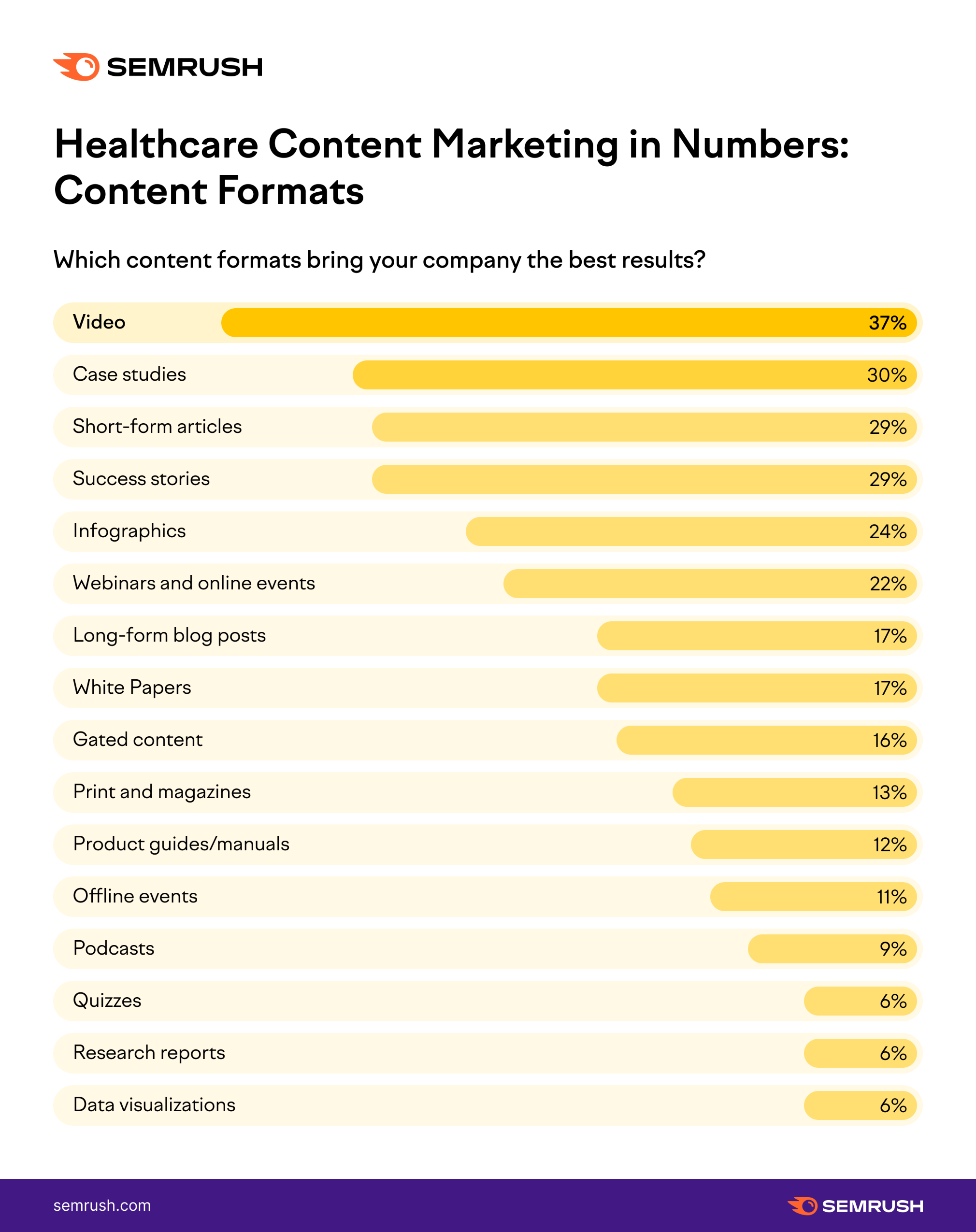
A relatively small percentage of healthcare companies tap into content formats like podcasts, data visualizations, ebooks, and quizzes. So, there’s enough room for getting creative and differentiating your brand from the competition.
Creative Healthcare Content Marketing Examples
Let’s look at some examples of how healthcare brands experiment with less traditional types of content.
1. Mayo Clinic’s Interactive U.S. COVID-19 map

This section of Mayo Clinic includes several interactive maps sharing the latest coronavirus data in the US.
The nature of this content format encourages users to return, generating thousands of shares and backlinks:

2. TikTok series by Purpose Med

Other healthcare marketers found social media video to be successful for them.
Edward Borenstein, Content Marketing Manager at PurposeMed, says:
We’ve found a lot of traction on TikTok recently with our content. Essentially our latest push has been a talking PrEP pill news anchor highlighting LGBTQ2S+ stories. This type of content has been the most successful for us so far. It’s a **** for getting the algorithm to realize our target demographic is predominantly queer while keeping the content engaging.
Here are some of our favorite videos created by the brand:
3. Downloadable content by Maven Clinic and Parsley Health
Interactive and downloadable (or gated) content can perform very well in healthcare, too. It can serve as an important source of leads for your sales team and for the email nurture workflows.
For instance, Maven Clinic’s checklists are informative, engaging, and answer their audience’s burning questions.

Parsley Health also does some incredible and informative guides.
These walk patients through gut health, good food preparation advice, and more. They do a great job at answering questions, reassuring patients, and helping people improve their quality of life.

4. The Due **** Calculator by What to Expect

Calculators and other free tools alike work great in the healthcare sector, Take, for example, the Due **** Calculator by whattoexpect.com.
It’s an excellent example of how knowing your audience’s pain points, you can come up with a simple, yet engaging and useful interactive piece of content.
The Calculator’s page has been attracting over 600k monthly organic views and had 3.8k backlinks as of June 2022:

5. Vicky Chan, MD’s TikTok account

Individual medical practitioners can also successfully grow their social media presence and their personal brands by sharing useful and entertaining content.
Vicky Chan’s TikTok page has already attracted over 400k followers and it keeps growing.
Check one of our favorite videos from this account explaining how to remove contact lenses pain-free and without damaging your eyes.
Step 4: Work with Medical Professionals to Ensure Compliance
Once you’ve selected and researched your topics, you need to leverage medical expertise to create your healthcare content. There are two ways to do this:
- You can work with experts from the outset to write/create the content
- Or you can use writers with medical experience to create the first drafts, and then have the content reviewed and verified by subject matter experts
The latter option is often the simplest way to proceed as it requires your experts less time.
Regardless of how you proceed, a great deal of care needs to be taken to create high-quality, accurate and verifiable content.
Stephen E. says:
If you have a platform of any kind, you have a responsibility to share clinically-vetted and accurate information with your audience, lest you mislead or misguide them for the sake of reaching your goals.
This becomes even more pertinent when considering your money or your life (YMYL) content. That is, information that affects your health or your finances.
Google, therefore, takes great pains to ensure that the healthcare information it shows in the search results is accurate, up-to-****, and from a reliable source.
If you don’t have clinical resources at your disposal, Stephen recommends seeking out answers from authoritative sources and medical professionals.
After all, when it comes to healthcare content, people’s well-being is on the line. He advises reaching out to department heads at universities or medical schools, who can often point you in the right direction if they can’t answer your questions themselves.
How Do Healthcare Companies Create Content?
One of our recent surveys focused found that businesses tend to use a mix of professional copywriters and subject matter experts.
53% of our respondents from various industries stated that their content is created by internal subject matter experts (SMEs).
And just over 43% have their copywriters create content with support from experts.
When we dive into healthcare companies specifically, we find that the majority have between one and three specialists on their content marketing team.

And specialists have a variety of roles:
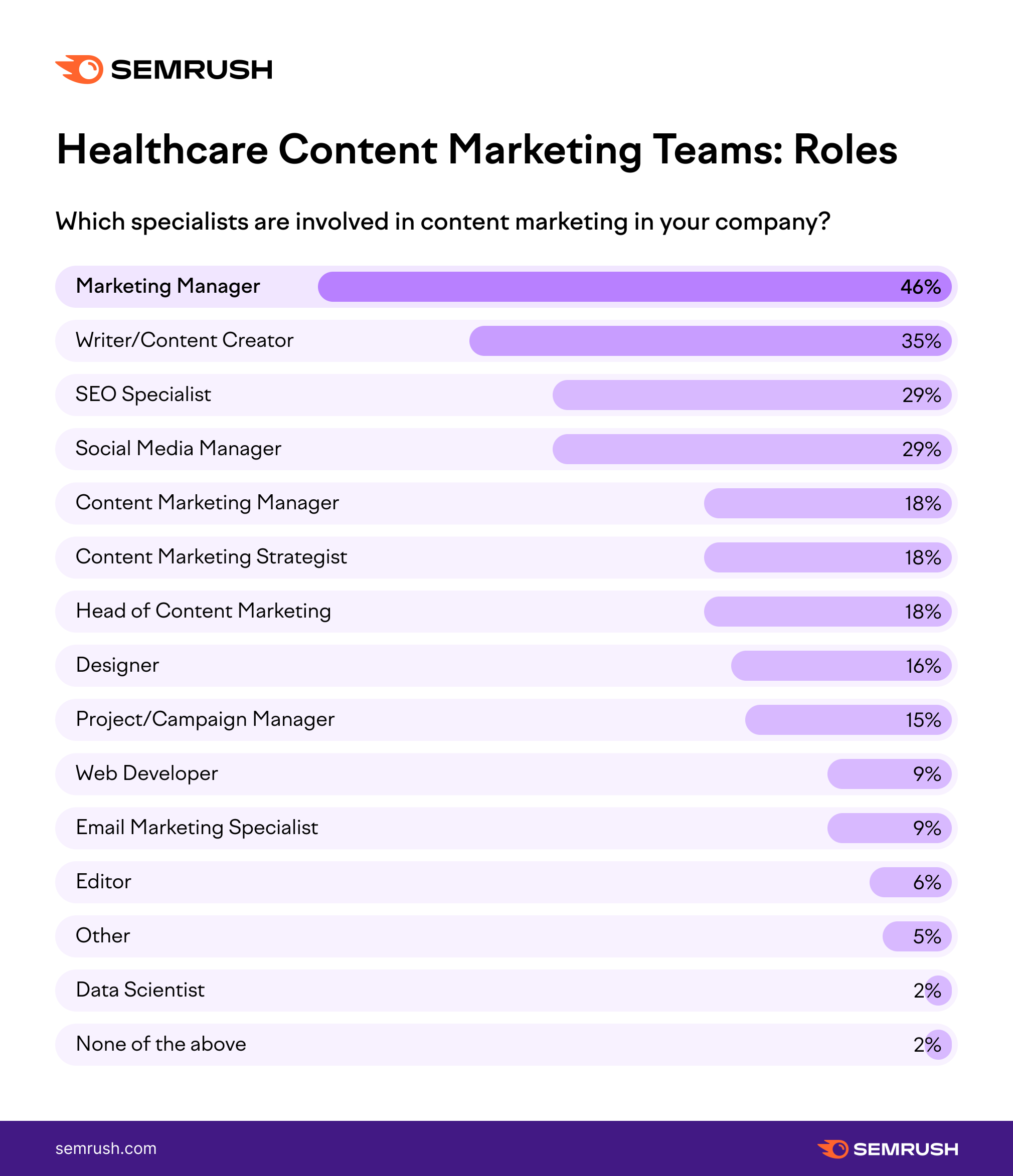
Finally, we saw that the majority of healthcare companies outsource content creation (62%).
This is probably done to help scale production or improve efficiency within the team.
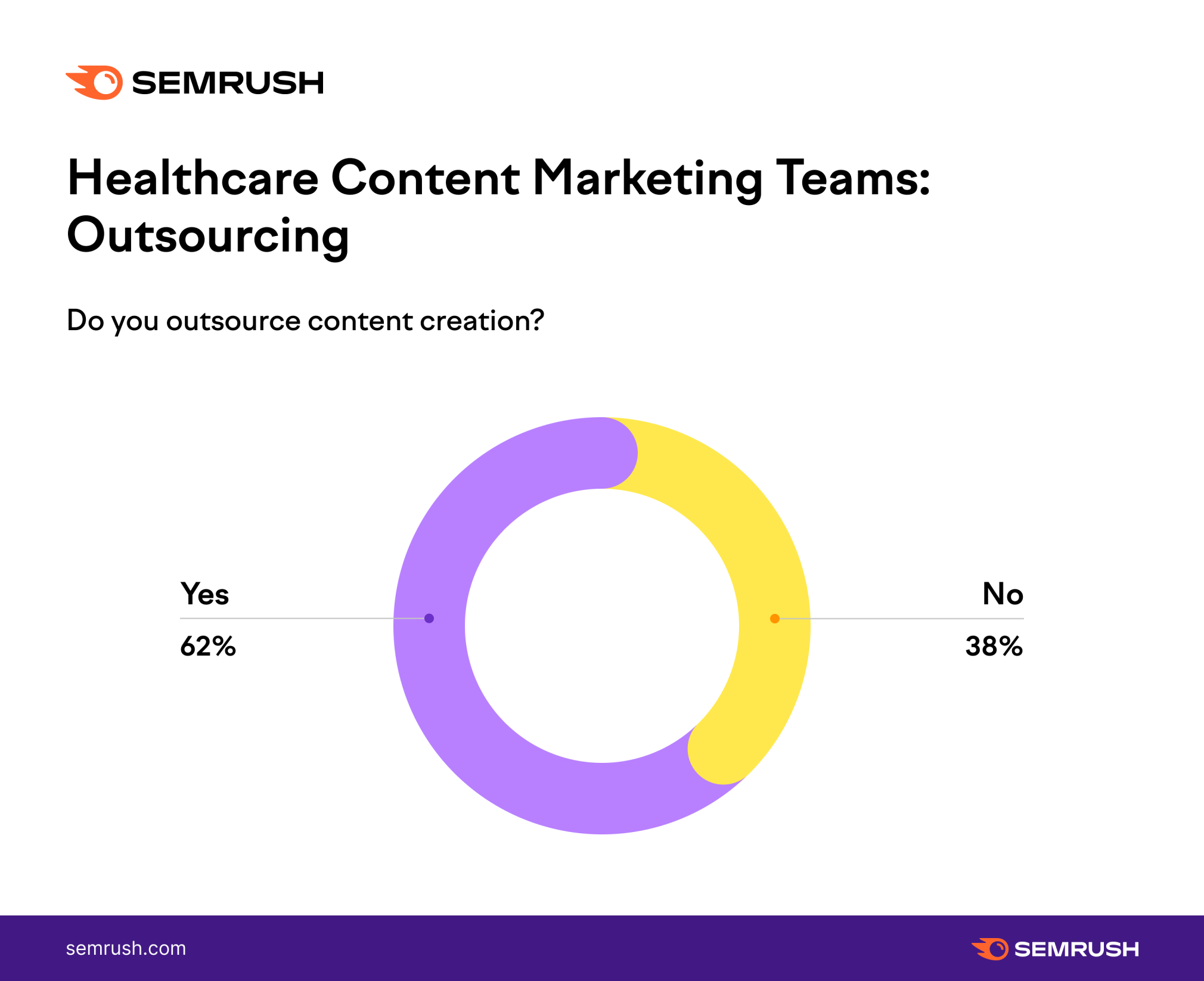
Edward Borenstein, Content Marketing Manager at PurposeMed, says:
Medical expertise will be required at some point along your creative process to publish health-based content. Have a writer that’s an expert on the article’s subject? Let them draft the first outline for you. Their ideas keep you informed and help you iterate on their work for SEO performance.
If your writers aren’t experts on the material, but better at writing and research, Edward advises recruiting a medical expert to review and fact-check pieces before publication.
Extra reviews of sensitive medical information are an additional safeguard that’s worth the cost.
What Does this Look Like in Practice?
Reputable healthcare Websites like WebMD show that their articles and information pieces are revised and approved by appropriate medical professionals.
For example:

They also have a section at the bottom of each article sharing the sources.

This practice helps WebMD establish E-A-T signals: Expertise–Authoritativeness–Trust factors that Google uses when deciding how to rank content in the search engine results pages.
However, enlisting the help of medical experts can add complexity to the process of creating healthcare content.
David McCarthy, Content marketing strategist, says:
Experts are likely to have limited availability. My preference is to get the medical expert involved as early as possible, highlighting how this piece of content will help advance the business and how they will be spotlighted in it, either as the author or editor. Generally, I’ve found that asking the expert for their point of view on the content can help engage them. However, it’s also critical that the content team comes prepared, knowing exactly what’s needed from them.
Step 5: Create a Better Content Experience: Enhance Structure, Add Visuals, and Maintain Clarity
The final step in boosting healthcare content strategy? Get your content organized and improve the overall content experience for your users.
When it comes to content marketing, quality is your number one ranking and differentiating factor. It helps you capture interest, engage your audience and convert them.
Make sure each content piece you publish is:
- Specific: It answers real doubts your readers have
- Logical: It follows a clear structure and is easy to skim
- Visual: It contains images or video that gets the message across quickly
- Targeted language: It uses simple, easy to understand language (even if you target B2B audiences)
- Reassuring: Your content should answer more questions than it raises and should point the reader in the direction of a healthcare provider if they need to answer more personal questions
- Experimental: You won’t know what content types work best for you unless you experiment. Use your audience research as a guide and see what works best for your audience.
We have analyzed some of the most popular healthcare websites in the US to identify several important patterns of successful content in this niche.
1. Organize your content in categories and hubs
Consider how your content relates to your customer’s questions, challenges, and pain points. Be sure to organize this information in a logical way.
For instance, if you are a health food-related provider, it may be worth having a content hub dedicated to vegan food.
In the example below, from Healthline, we can see how articles are related to certain health complaints or areas of interest, like Hypertension and Heart Disease.

2. Make sure content can be easily found on your website
User experience is a top consideration. Make sure that your content is organized in such a way that content can be discovered easily through browsing, as well as through keyword searches on the website.
Not only is this important for your readers, but also for the search engines too.
First, your website visitors will stick around for longer if they can find what they need, with no stress. And second, the search engines will better understand how the content is categorized. This will potentially help you when it comes to search engine rankings.
Below you can see all conditions on the Mayo Clinic in the alphabetical order:

On a related note, it’s never a bad idea to make things interactive. The Mayo Clinic also includes an easy, interactive search process:

3. Structure your articles clearly and improve readability
Clarity, advanced structure, and plain language are essential to ensure your text content is pleasant to read.
Adding a logical, easy-to-follow heading structure will help your readers skim your text.
Besides, it’ll also make it easier for Google to crawl your article.
For that reason, you should always start writing by building an outline. It’s also important to look for opportunities to add lists and white spaces.
AI content tools like ContentShake can help you streamline this process.
All you need to do is choose a content idea from those suggested by the tool (or add yours) and let AI do its magic.
You’ll get an optimized outline and data-driven suggestions for various parts of your article in an instant. For instance, you’ll see keywords and statistics to include in your blog post.
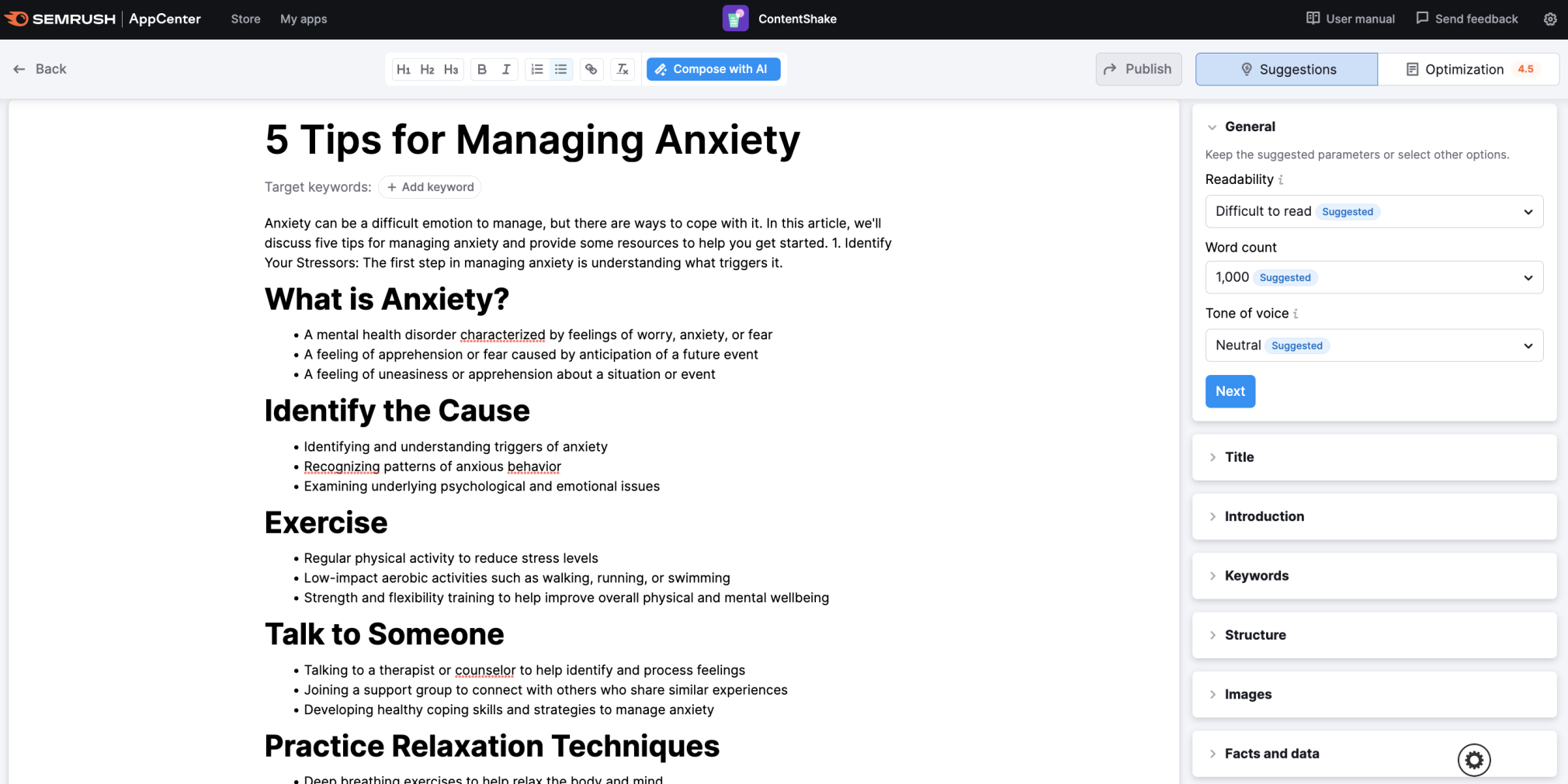
Continuing with the Mayo Clinic as an example, we can see how content that is easy to follow and understand—or can be considered easily scannable—improves the reader experience.
This article on Mayo Clinic does a great job. See how the use of a table easily categorizes UTIs:

Adding a clickable and detailed table of contents is another way to improve the reader experience. Check out an example from What to Expect below:

Another important aspect to consider is maintaining an optimal readability level. To optimize your content and improve its readability, make sure to:
- Avoid using words that are too lengthy and complex
- Keep your sentences short and sweet
- Break down lengthy paragraphs
ContentShake can help you with this task as well.
Once you have your blog post ready, the tool will score it across three main pillars: readability, SEO, and tone of voice.
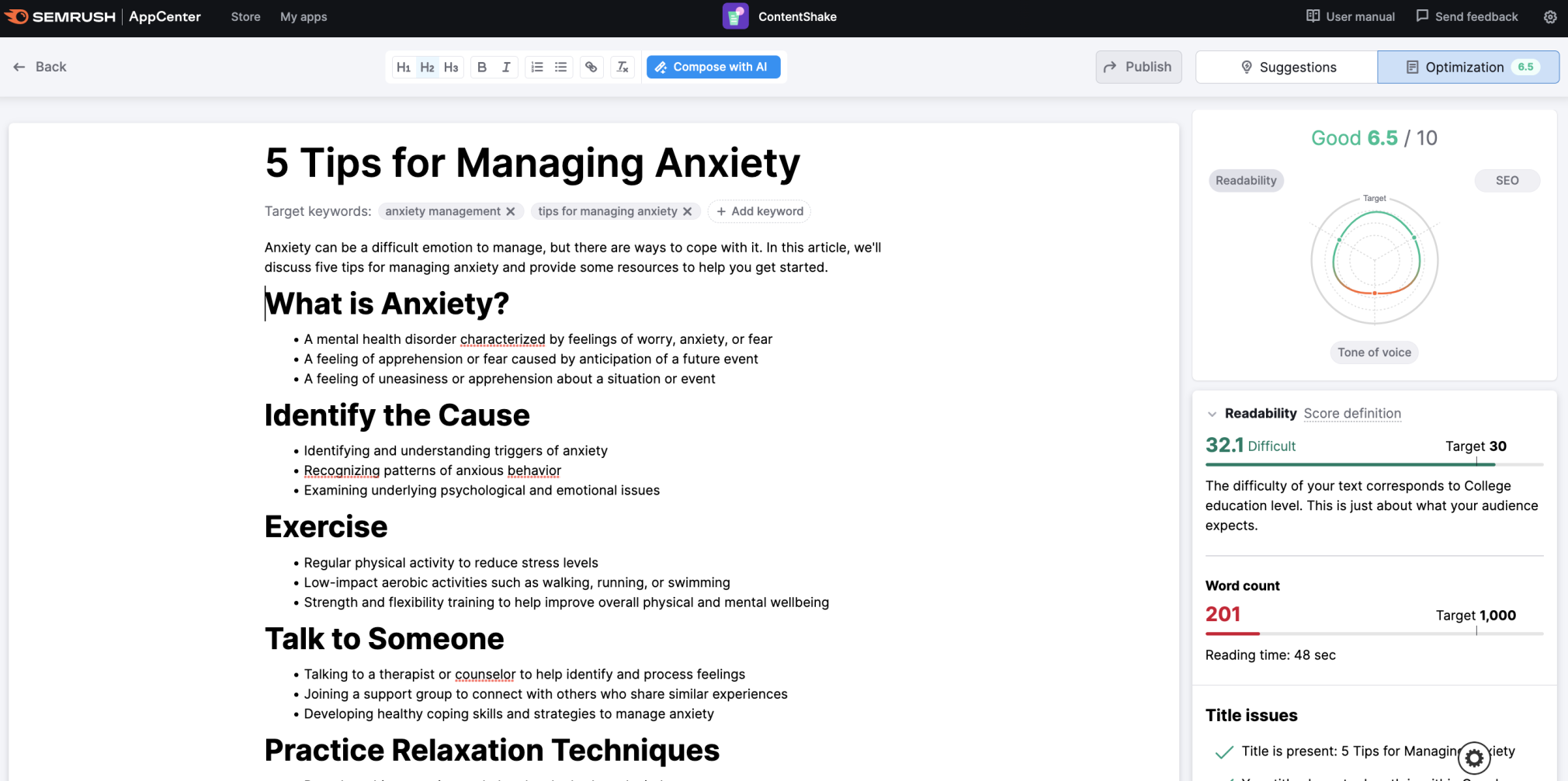
You can then see all paragraphs and sentences that need to be adjusted and improve them in one click using AI.
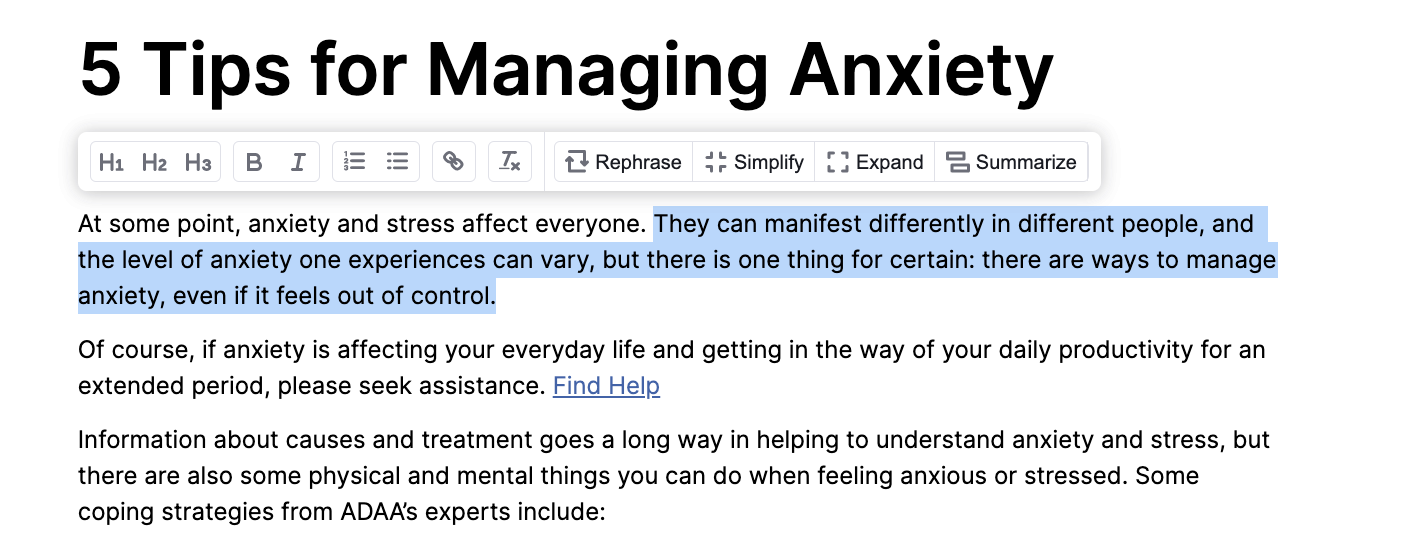
4. Where needed, use visuals to reduce the burden on the reader
Sometimes content consumers don’t want to read huge swaths of text.
Integrating images, infographics, and video can better illustrate your points. It can give your content a more human touch and (often) makes things easier to understand.
In our own analysis of the Anatomy of Top Performing Organic Content, we found that articles with seven or more images get the most backlinks (a percentage increase of 555% compared to those with no images) and the most organic traffic (a 259% increase).
We also saw that articles with at least one video generate 70% more organic traffic than those without.
Janne Marie Wendel says:
Make sure you use references and images that the audience can recognize. For example, suppose you live in an area with cold winters and write about aches in the joints, and then don’t mention that many feel more stiff and achy during the cold periods. People might think that you’re not concerned about their experiences, and you can lose credibility (you don’t seem to solve their problem).
To illustrate, this article on What to Expect does a good job of integrating relevant video into the flow of the blog post:

Other visual formats that can enrich your content include infographics, video interviews, gifs, as well as images with graphs and statistics.
Final Words
Content marketing can differentiate your healthcare company from the competition and help you build a loyal community. The key to success lies in your ability to focus on customer insights when producing content, adhere to the highest quality standards, and opt for creativity.
Our ContentShake tool can help healthcare organizations create high-quality, effective content and build data-driven content strategies.
See how it can increase your organic traffic and improve your SEO results in the long term.
Source link : Semrush.com
